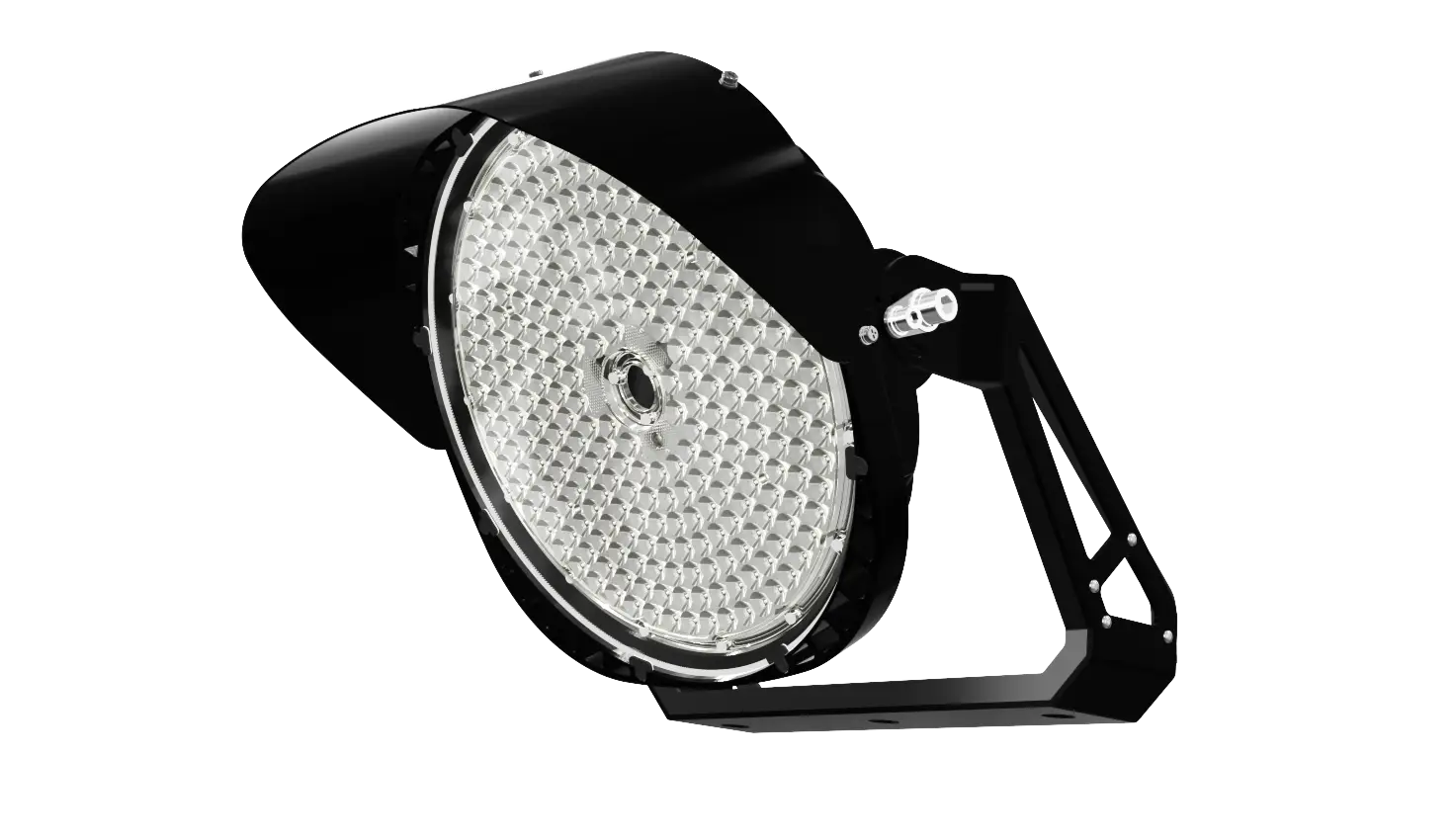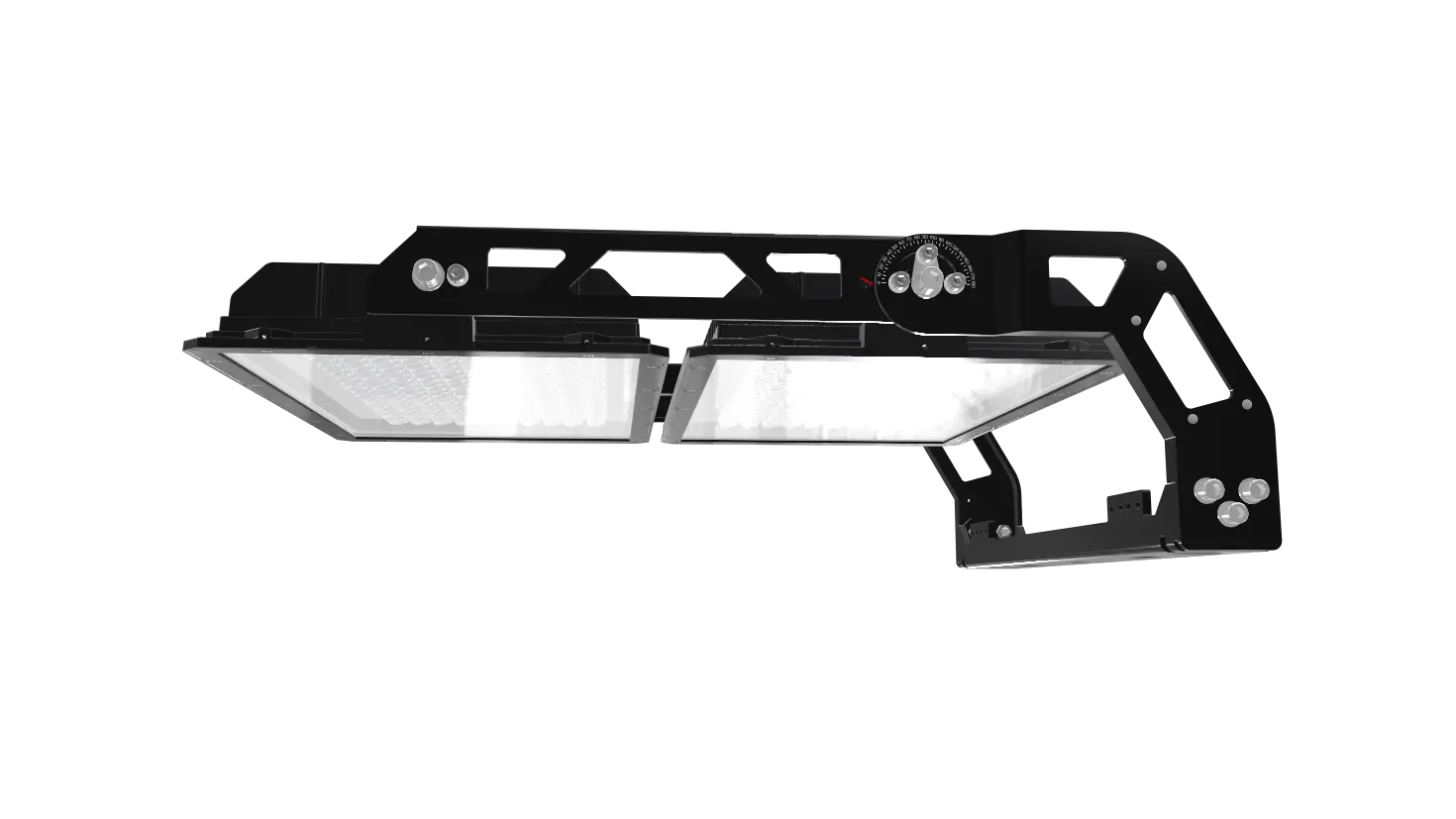LED野球場照明を選ぶべき理由
照明は野球の試合の成否を左右します。選手の安全を守り、パフォーマンスを向上させ、ファンがすべてのプレーを追えるようにします。しかし、メタルハライドライトのような時代遅れの照明はどうでしょうか?ウォームアップに15~20分かかり、30%も多くエネルギーを消費し、すぐに消耗してしまいます。だからこそ、LED野球場照明が主流になりつつあります。明るく、エネルギー効率が高く、長持ちするように設計されているからです。
このガイドでは、LEDを選ぶ主な理由と、フィールド(リトルリーグ、プロ、レクリエーション)に適したルーメンの選び方を詳しく説明し、賢く長期的な選択ができるようにしています。
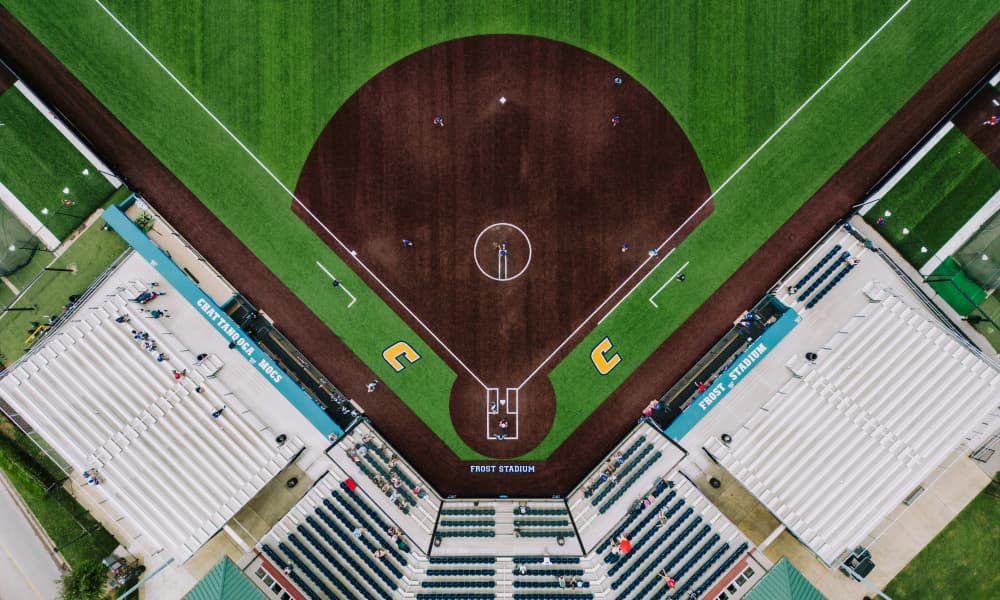
ディレクトリ:
2. スポーツフィールドにおける従来の照明とLED照明の比較
1. LED野球場照明とは?
LED野球場照明は、競技エリア全体を明るく照らすために特別に設計された高出力投光器です。従来のメタルハライドランプとは異なり、これらのLED器具は瞬時に最大輝度を実現し、優れたエネルギー利用率と大幅に長い耐用年数を誇ります。
フィールド全体に均一な配光を実現するために、これらのLED照明は会場の照明ポールに設置されます。取り付け高さと投光角度は事前に慎重に計算されています。適切に設計された照明システムは、強いグレアを効果的に最小限に抑え、影の領域を減らし、暗い場所を排除することで、選手にとって安全な競技環境を作り出します。
最新の野球場照明は、正確なビーム制御機能も備えています。この機能を活用することで、照明器具は野球場の厳しい照明要件を満たしながら、エネルギー消費を約60%削減できます。
さらに、堅牢なハウジングと高い耐候性を備えているため、小さなコミュニティパークのフィールドから大規模なプロスポーツ会場まで、信頼性の高い運用が可能です。
まとめると、LED野球場照明は、強力な照明、優れた省エネ性能、安定した光出力を兼ね備えており、現在の野球場の照明設備や古い照明システムのアップグレードに最適な選択肢となっています
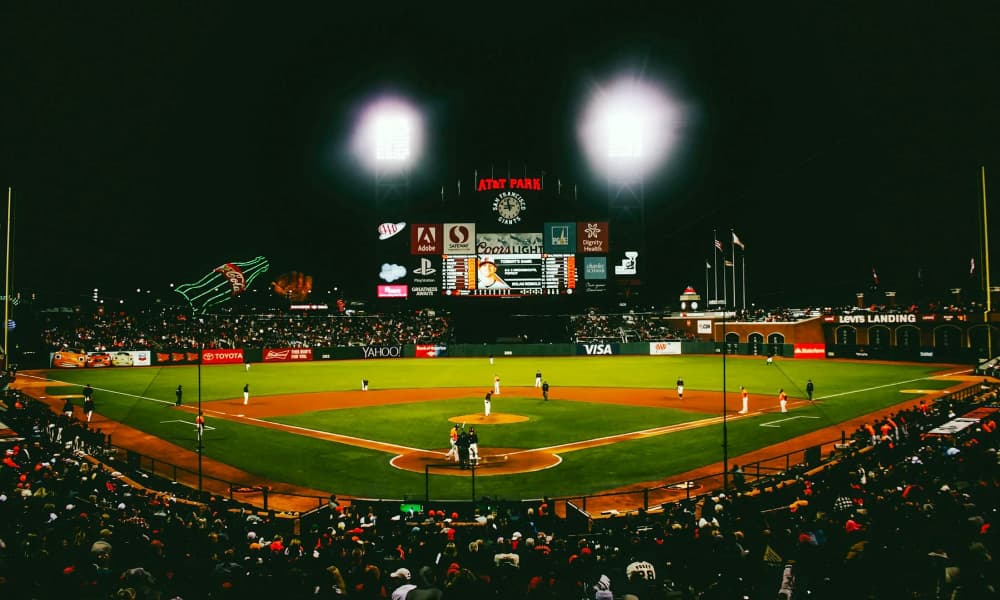
2. スポーツフィールドにおける従来の照明とLED照明の比較
野球場では長年、主にメタルハライドランプ(MH) と高圧ナトリウムランプ(HPS)といった従来の高輝度放電ランプ(HID)が使用されてきました。これらのシステムはかつて標準でしたが、重大な欠点もありました。
l MHランプは明るい白色光を発しましたが、ウォームアップ時間が長く、ルーメンが急速に低下するという問題がありました。
l HPSランプは効率は優れていましたが、黄橙色の光を発し、視認性と演色性が低下していました。
視認性、エネルギー効率、メンテナンスの低減に対する需要が高まるにつれ、これらの古い技術はLED野球場照明に置き換えられつつあります。LEDはMHとHPSの限界を克服するだけでなく、瞬時の起動、より高い光質、大幅に長い寿命などの新しい利点も備えています。
以下の比較は、野球場におけるMH、HPS、LEDソリューションの主な違いを示しています。
比較:MH vs HPS vs LED

つまり、LED野球場照明は、 効率性、耐久性、優れた視認性を兼ね備えているため、MHとHPSの両方を明らかに上回って おり、スポーツ照明のアップグレードにおける現代の標準となっています。
3. 野球場にLED照明を選ぶ理由
LED野球場照明への切り替えは、技術面だけでなく、運営者、選手、観客にとっての実用的なメリットも重要です。
(1) 運用コストの削減
LEDは、HIDランプやMHランプと比較して、エネルギー消費を最大70%削減します。コミュニティフィールドでは、これは毎シーズン数千ドルの節約につながります。電力使用量の削減は、持続可能性の目標達成にも貢献します。
(2) 最小限のメンテナンス
寿命が50,000~100,000時間に達するLEDは、従来のランプに比べて交換回数がはるかに少なくて済みます。電球交換の回数が減れば、ダウンタイムが減り、メンテナンス費用も削減されます。
(3) より良いプレー環境
LEDは、安定した明るさと高い演色性(CRI)を提供します。選手はボールを追跡しやすくなり、ナイトゲームは日中の状況に近い感覚になります。影や暗い部分が最小限に抑えられ、フィールド上の安全性が向上します。
(4) 観戦体験の向上
均一な照明により、スタンドやライブ放送での視認性が向上します。ファンはグレアやちらつきのない明瞭な映像を観戦でき、試合をより楽しむことができます。
(5) 柔軟な制御
LEDシステムはスマートコントロールと統合されており、オペレーターは練習、公式試合、特別なイベントに合わせて明るさを調整できます。調光、ゾーニング、スケジュール設定など、すべてが可能で、これは古いシステムでは実現できません。
(6)将来を見据えた投資
初期費用は高くなりますが、長期的なエネルギーとメンテナンスの節約は大きな利益をもたらします。多くの施設では、数年以内に投資を回収しています。
つまり、野球場にLED照明を選択することは、より安全な試合、より低い電気代、そしてより良いファン体験を意味します
4. 最適なLED野球場照明の選び方
適切なLED野球場照明を選ぶには、単に器具を選ぶだけでなく、フィールドの種類、競技レベル、長期的な予算に合わせて選ぶことが重要です。賢い選択をする方法をご紹介します。
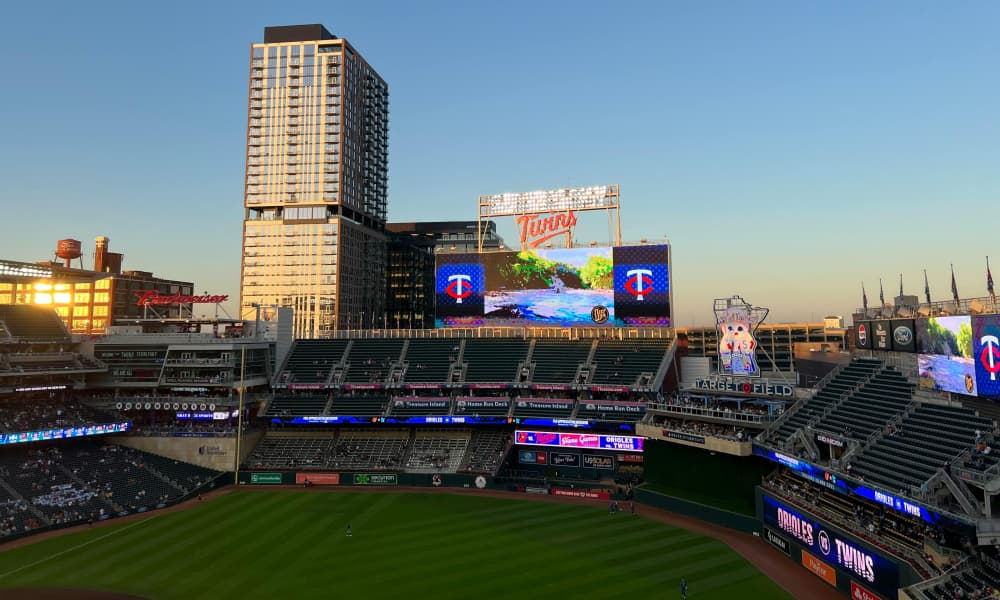
① フィールドの種類と競技レベルを定義する
照明のニーズは、プレーのレベルによって異なります
l レクリエーション/リトルリーグ:30~50フットカンデラ、通常20~30灯
l 高校/大学:50~70フットカンデラ、約30~60灯
l プロスタジアム: 70~100フットカンデラ以上、多くの場合100灯以上
自分のレベルを知ることで、明るさと照明器具数の基準が決まります。
② ワット数とルーメンを合わせる
ワット数ではなくルーメンを見てください。 例えば、1,200WのLED照明器具は160,000ルーメン以上の光を出力できます。レクリエーションフィールドでは合計150~200万ルーメンが必要になる場合がありますが、プロレベルのスタジアムでは800万ルーメンを超える場合があります。常に照明器具の出力とポールの配置のバランスをとってください。
③ ビーム角と光学系
ナロービーム(15~30°)は高いポールからの遠投をカバーし、ワイドビーム(40~60°)は内野や観客席全体に光を広げます。混合ビーム設計により、影のない均一な照射範囲が確保されます。
④ ポールの高さと配置
一般的なポールの高さは40~100フィートです。小規模なフィールドでは40~60フィート、スタジアムでは80~100フィートが必要になることがよくあります。グレアやホットスポットを避けるには、高さだけでなく、正しい間隔と照準も重要です。
⑤ 耐久性と保護
屋外野球場のLEDライトは、 雨、ほこり、風に耐える必要があります。IP65+保護と耐腐食性ハウジングを探してください。沿岸地域では、耐塩仕上げを選択して耐用年数を延ばしてください。
⑥ 制御オプション
最新のシステムには、調光、タイマー、リモコンが備わっています。スマートな管理により、年間10~20%の運用コストを削減し、ROIを向上させることができます。
⑦ 規格への準拠
IESまたはCIEの照明ガイドラインを必ずご確認ください 。専門的な測光設計により、設置前にフィールドが安全性と視認性の基準を満たしていることが保証されます。
以下は簡単なチェックリストです。この手順に従うことで、持続的な性能、省エネ、そしてプロフェッショナルな視認性を実現するLED野球場照明を選択できます。
フィールドの種類/レベル | ターゲットフットカンデラ | 必要な総ルーメン | 器具数 (おおよそ) | ポールの高さ範囲 |
レクリエーション/リトルリーグ | 30~50フィート | 1.5メートル~2メートル | 20~30 | 40~60フィート |
高校/大学 | 50~70フィート | 3メートル~5メートル | 30~60 | 60~80フィート |
プロスタジアム | 70~100フィート以上 | 6メートル~8メートル以上 | 100以上 | 80~100フィート |
5. 野球場照明の費用は?
LED野球場照明の費用は、フィールドの広さ、競技レベル、必要な器具の数、設置の複雑さなど、いくつかの要因によって異なります。購入価格に加えて、長期的なエネルギーとメンテナンスの節約も総所有コストに影響します。
5.1 初期購入および設置費用
① 器具価格:高品質LEDスポーツライト1台(1000~1500W相当)は、通常1台あたり800ドルから2,000ドルの範囲です。
② 器具数:
l リトルリーグのフィールド(ベース60~70フィート)には通常、20~30個の器具が必要です。
l 高校/大学のフィールド(ベース90フィート、外野が広い)には、30~40個の器具が必要です
l Professional fields may require 60+ fixtures to meet broadcast-level lighting standards.
③ Poles & Mounting: Poles, brackets, and cabling add significant cost, often accounting for 30%–40% of the total budget.
④ Installation Labor: Professional installation (pole erection, wiring, aiming) can add another $20,000–$50,000, depending on the site conditions.
On average, a Little League field may cost $80,000–$120,000 for a full LED system, while a professional stadium can exceed $500,000.
5.2 Operating & Maintenance Costs
Energy Consumption: LED lights use 40%–60% less electricity than metal halide or HPS lamps. A full field setup may consume 30–50 kW per game, compared to 60–100 kW with traditional lights.
Maintenance: LEDs offer 50,000–100,000 hours of lifespan, reducing the need for frequent bulb replacement and lift-truck rental. Over a decade, this can save tens of thousands of dollars compared to traditional systems.
5.3 Return on Investment (ROI)
Switching to LED is not only about better lighting—it’s also a financial decision.
① Energy Savings: Lower power bills quickly add up. A mid-sized field can save $10,000–$20,000 annually on electricity.
② Reduced Maintenance: Avoiding frequent bulb replacements and labor reduces annual expenses by another $5,000–$10,000.
③ Payback Period: Most fields see a 3–6 year ROI, after which the system continues delivering savings.
Added Value: Brighter, uniform, and flicker-free lighting enhances player performance, fan experience, and even broadcasting opportunities—indirectly contributing to revenue growth.
6. Baseball Field Lighting Design & Installation
Designing and installing LED lighting for a baseball field is more than just putting fixtures on poles—it requires a balance of engineering, safety, and visual performance. The goal is to achieve uniform brightness, minimal glare, and reliable coverage across the infield and outfield.
Below are the most common mounting and installation methods used for baseball field lights.
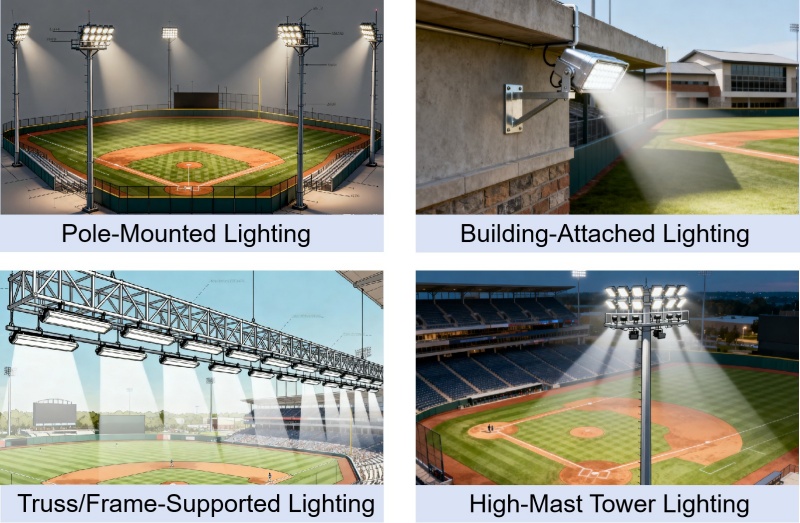
6.1 Pole-Mounted Lighting
l Most common solution for community, school, and semi-professional fields.
l Poles are typically 40–100 ft tall, depending on field size and level of play.
l Materials include galvanized steel or aluminum to withstand wind, rain, and long-term exposure.
l Fixtures are mounted at specific angles (usually 15°–60° beam angles) to avoid shadows and provide smooth coverage.
l For small fields (Little League), 4–6 poles may be enough, while full-size stadiums require 6–8 or more.
Advantage: Flexible for different field sizes, cost-effective for schools and community sports.
Limitation: Requires sufficient space around the field perimeter.
6.2 Wall- or Roof-Mounted Lighting
l Used when the field is close to school buildings, gym walls, or nearby structures.
l Eliminates the need for poles, reducing installation cost and space requirements.
l Works well for smaller training fields or urban locations where space is limited.
Advantage: Saves pole installation cost.
Limitation: Limited mounting height may reduce lighting uniformity for larger fields.
6.3 High-Mast Tower Lighting
l Ideal for multi-purpose stadiums or larger baseball complexes.
l Poles or towers can reach 150–250 ft, allowing a wide beam spread across the entire field.
l High masts often support multiple fixtures per tower, reducing the number of poles required.
Advantage: Excellent coverage, fewer poles needed.
Limitation: Higher upfront cost and engineering requirements.
6.4 Truss or Frame-Mounted Lighting
l Common in college and professional stadiums where poles near the field would obstruct sightlines.
l Fixtures are mounted on roof trusses, structural frames, or catwalks above the stands.
l Provides excellent lighting angles from above, ensuring uniform illumination for both players and broadcast cameras.
Advantage: No poles on the field perimeter, better viewing experience for fans.
Limitation: Only suitable for large stadiums with strong structural support.
6.5 Key Design Considerations
l Beam Angle & Positioning: Avoids shadows and dark spots in the outfield.
l Uniformity Ratio: Target of 0.5 or higher ensures balanced light across the field.
l Glare Control: Anti-glare lenses and shielded optics help protect players’ and spectators’ eyes.
l Weather Durability: Fixtures must be IP65+ rated to resist rain, wind, and dust.
Wiring & Power: Underground conduits and weatherproof connections ensure safety and reliability.
7. Conclusion
LED baseball field lights have become the clear choice for modern sports facilities. Compared with traditional HID, metal halide, or high-pressure sodium lamps, LEDs deliver higher efficiency, longer lifespan, and far lower maintenance. They also provide consistent brightness and meet strict baseball field lighting standards for both infield and outfield play.
From cost savings on energy to flexible design options with poles, masts, or trusses, LEDs make it easier to achieve professional-level visibility. Whether planning for a local league, high school, or professional stadium, the right design ensures proper lumen output, correct mounting height, and uniform coverage.
Investing in LED baseball field lights is not just a short-term upgrade—it is a long-term solution that improves player safety, spectator experience, and operational efficiency.
8. FAQs
8.1 How Many Lumens Are Needed to Light a Baseball Field?
The lumen requirement depends on the competition level. Little League or recreational fields may need 30,000–50,000 lumens per fixture, while high school and college fields often require 70,000–100,000 lumens per fixture. Professional stadiums with TV broadcasting can exceed 200,000 lumens per fixture. The goal is to reach 30–100 foot-candles on the infield and 20–50 foot-candles on the outfield.
8.2 What's the Best Height to Mount Baseball Field Lights?
小規模な競技場では、ポールの高さは通常40~60フィートです。高校やコミュニティ競技場では、60~80フィートのポールがよく使用されます。大規模なスタジアムでは、より広い範囲をカバーし、グレアを軽減するために、高さが100フィート以上になることもあります。適切な高さは、ビーム角度、ポールの位置、競技場の広さによって異なります。設置位置が低すぎると影ができ、高すぎると効率が低下します。
8.3 野球場に必要なスタジアム照明の数は?
照明の数は、競技場の広さや競技レベルによって異なります。リトルリーグの競技場では20~30個の照明器具が使用される場合がありますが、高校や大学の競技場では30~60個の照明器具が必要になることがよくあります。プロの競技場では、ポール、マスト、またはトラスに100個以上の照明器具を設置する必要がある場合があります。配置は照明器具の数と同じくらい重要です。内野と外野を均一に配置することで、選手がボールを見失うことがなくなります。
8.4 野球場の照明の運用コストは?
ランニングコストはワット数、器具の数、使用時間によって異なります。1,200WのLED器具を40個設置した典型的な高校のグラウンドでは、1時間あたり約48kWを消費します。1kWhあたり0.12ドルとすると、1時間あたり約6ドルになります。
古いメタルハライドシステムは、ワット数が高く効率が悪いため、2~3倍のコストがかかる可能性があります。LEDライトは、特に調光制御やスケジュール運転と組み合わせることで、運用コストを大幅に削減します。
関連製品
_thumb.jpg)
